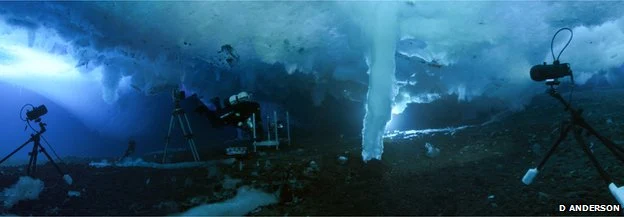HAS BEEN FILMED BY A BBC CREW.
Creeping ice
A very cool video of an “icicle of
death” was filmed with time-lapse camera in the freezing waters of the deep. The
unusual phenomenon was filmed for the first time by cameramen Hugh Miller and
Doug Anderson for the BBC One series Frozen Planet and is one of the
most amazing shots ever recorded.
In the video, we can appreciate as the icy finger forms. It
grows slows but when it touches down on the ocean floor, as it entombs whatever
life-form that happens to be in its path.
Starfish and sea-urchins shrivel up and die, encased in a “tomb
of ice” as the frozen tornado whirls its destructive path to the sea floor.
Freezing sea water doesn’t make ice like the stuff you grow in
your freezer. Instead of a solid dense lump, it is more like a seawater-soaked
sponge with a tiny network of brine channels within it
The “icicle of death” is caused by cold, sinking brine, which is
denser than the rest of the sea water. It forms a brinicle as it contacts
warmer water below the surface.
Brinicles
are found in both the Arctic and the Antarctic, but it has to be relatively
calm for them to grow as long as the ones the Frozen Planet team observed.
They used to be called ice
stalactites until 1974, until a new theory was advanced as to how they are
created.
In winter, the air
temperature above the sea ice can be below -20C, whereas the sea water is only
about -1.9C. Heat flows from the warmer sea up to the very cold air, forming
new ice from the bottom. The salt in this newly formed ice is concentrated and
pushed into the brine channels. And because it is very cold and salty, it is
denser than the water beneath.
The result is the brine
sinks in a descending plume. But as this extremely cold brine leaves the sea
ice, it freezes the relatively fresh seawater it comes in contact with. This
forms a fragile tube of ice around the descending plume, which grows into what
has been called a brinicle.
The extremely salty 'brinicle' is not quite a solid icicle. The
sea water is only forming a frozen 'sheath' around the cold saline, rather than
freezing all the way through. Dr Mark Brandon, a polar oceanographer, described
it as "a seawater-soaked sponge with a tiny network of
brine channels within it."
Mr. Miller set up the rig
of time lapse equipment to capture the growing brinicle under the ice at Little
Razorback Island, near Antarctica’s Ross Archipelago. Navigating
the icy ocean floor amid sea proved difficult. Inquisitive seals pushed the
camera about.
.
“When we were exploring
around that island we came across an area where there had been three or four
[brinicles] previously and there was one actually happening,” Mr Miller told
BBC Nature.
The diving specialists
noted the temperature and returned to the area as soon as the same conditions
were repeated.
“It was a bit of a race
against time because no-one really knew how fast they formed,” said Mr. Miller.
“The one we’d seen a week
before was getting longer in front of our eyes… the whole thing only took five,
six hours.”
.
Read the full article: BBC
News




No comments:
Post a Comment
If your comment is not posted, it was deemed offensive.